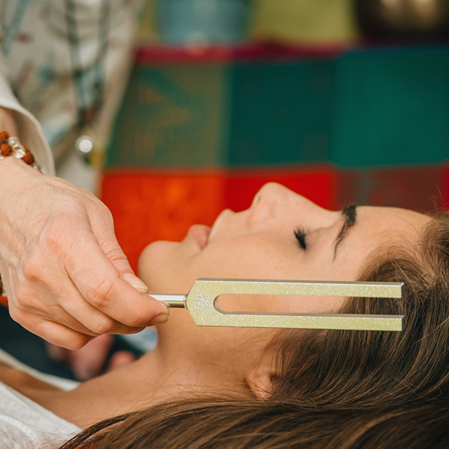
Vibration therapy
Alternative names: Biomechanical Muscle Stimulation, Biomechanical Oscillation, Biomechanical Stimulation, Direct Vibration, Focal Muscle Vibration, Local Vibration Therapy, Low Frequency Sound Stimulation, Mechanostimulation, Physioacoustic Vibration, Rhythmic Sensory Stimulation, Sound Vibrational Therapy, Sound Wave Vibrational Therapy, Vibration Foam Rolling, Vibration Healing, Vibration Medicine, Vibrational Medicine, Vibrational Therapy, Vibration Training, Vibroacoustic Therapy, Vibrotherapy, Whole Body Vibration Exercise, Whole Body Vibration Therapy
Background
Vibration therapy uses vibration to promote health. Vibration can be applied directly to the body with tools or through sound waves.
It's not clear what effects vibration therapy has on the body, but there's interest in its use for increasing bone and muscle mass, improving balance and movement, and reducing pain. Mechanical vibration therapy uses tools to apply vibration. Sound wave vibration therapy (vibroacoustic therapy) uses sound waves.
People use vibration therapy for athletic performance, osteoporosis, anxiety, back pain, fall prevention, multiple sclerosis, pain, and many other conditions, but there is no good scientific evidence to support these uses.
Some types of vibration therapy use sound waves and music. Don't confuse this with music therapy. These are not the same.
It's not clear what effects vibration therapy has on the body, but there's interest in its use for increasing bone and muscle mass, improving balance and movement, and reducing pain. Mechanical vibration therapy uses tools to apply vibration. Sound wave vibration therapy (vibroacoustic therapy) uses sound waves.
People use vibration therapy for athletic performance, osteoporosis, anxiety, back pain, fall prevention, multiple sclerosis, pain, and many other conditions, but there is no good scientific evidence to support these uses.
Some types of vibration therapy use sound waves and music. Don't confuse this with music therapy. These are not the same.
Safety Safety definitions
Mechanical vibration therapy, which delivers vibration with massage tools or other mechanical equipment, is possibly safe when applied appropriately. There isn't enough reliable information to know if vibration therapy that uses low-frequency sounds waves (vibroacoustic therapy) is safe or what the side effects might be. But there's no reason to expect safety concerns when used short-term.
Special Precautions & Warnings:
Pregnancy and breast-feeding: There isn't enough reliable information to know if vibration therapy is safe to use when pregnant or breast-feeding or what the side effects might be. But there's no reason to expect safety concerns when used short-term.Effectiveness
NatMed Pro rates effectiveness based on scientific evidence according to the following scale: Effective, Likely Effective, Possibly Effective, Possibly Ineffective, Likely Ineffective, Ineffective, and Insufficient Evidence to Rate.
Possibly ineffective Effectiveness definitions
- Athletic performance. Whole-body mechanical vibration therapy, which delivers vibration with massage tools or other mechanical equipment, doesn't seem to improve athletic performance in athletes.
- Weak and brittle bones (osteoporosis). Whole-body mechanical vibration therapy, which delivers vibration with massage tools or other mechanical equipment, doesn't improve bone mass in adults with weak and brittle bones.
Dosing & administration
Vibration therapy can be given as mechanical vibration therapy or sound wave vibration therapy. Speak with a healthcare provider to find out how to use vibration therapy for a specific condition.
Mechanical vibration therapy uses massage tools or other special equipment to apply vibration to the whole body or specific parts of the body. Sessions can be done once or on a weekly or daily basis. They may be self-applied or given by a practitioner.
Sound wave vibration therapy, also known as vibroacoustic or physioacoustic therapy, uses low-frequency sound waves. The vibrations come from speakers that are embedded in equipment like a chair or mattress. Treatments may occur once or multiples times daily for up to 12 weeks.
Mechanical vibration therapy uses massage tools or other special equipment to apply vibration to the whole body or specific parts of the body. Sessions can be done once or on a weekly or daily basis. They may be self-applied or given by a practitioner.
Sound wave vibration therapy, also known as vibroacoustic or physioacoustic therapy, uses low-frequency sound waves. The vibrations come from speakers that are embedded in equipment like a chair or mattress. Treatments may occur once or multiples times daily for up to 12 weeks.
Interactions with pharmaceuticals
It is not known if this treatment interacts with any medicines. Before using this treatment, talk with your health professional if you take any medications.
Interactions with herbs & supplements
There are no known interactions with herbs and supplements.
Interactions with foods
There are no known interactions with foods.
vital.ly has licensed monographs from TRC Healthcare.
This monograph was last reviewed on 18/11/2024 11:00:00. Monographs are reviewed and/or updated multiple times per month and at least once per year.
Natural Medicines disclaims any responsibility related to medical consequences of using any medical product. Effort is made to ensure that the information contained in this monograph is accurate at the time it was published. Consumers and medical professionals who consult this monograph are cautioned that any medical or product related decision is the sole responsibility of the consumer and/or the health care professional. A legal License Agreement sets limitations on downloading, storing, or printing content from this Database. No reproduction of this monograph or any content from this Database is permitted without written permission from the publisher. It is unlawful to download, store, or distribute content from this site.


